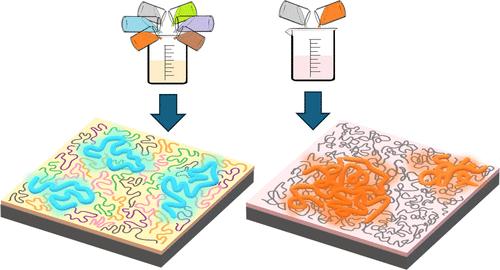Our official English website, www.x-mol.net, welcomes your
feedback! (Note: you will need to create a separate account there.)
Photonics of High-Entropy Polymers Revealing Molecular Dispersion via Polymer Mixing
ACS Nano ( IF 15.8 ) Pub Date : 2024-11-16 , DOI: 10.1021/acsnano.4c10585 Yu-Jr Huang, Jien-Wei Yeh, Arnold Chang-Mou Yang
ACS Nano ( IF 15.8 ) Pub Date : 2024-11-16 , DOI: 10.1021/acsnano.4c10585 Yu-Jr Huang, Jien-Wei Yeh, Arnold Chang-Mou Yang

|
Blending multiple polymers together to form the so-called “high-entropy polymers (HEPs)” can generate the effects of molecular dispersion in addition to suppressing polymer phase separation. We embedded a semiconducting polymer (conjugated polymers, CPs) in an optically inert matrix composed of n polymer species and found that a molecule-level dispersion is attained in HEPs defined as n ≥ 5. In the regime of dilute CP concentrations, the photonic properties vary widely in the n = 1 matrices owing to diverse solubility parameters, but the distribution narrows with n, and the CP starts to exhibit behaviors of molecule-level dispersion at n ≥ 5, where the matrix polymers compete with each other to exert direct influences on the embedded CP. Specifically, for MEH-PPV, increasing n reduces the fluorescence redshift and spectral width from diminishing aggregation. For the rigid PFO molecules, increasing n creates a dilution effect facilitating formation of the low-energy planar β-phase. For the flexible regioregular P3HT-rr, HEPs offer well-dispersed amorphous chains highly susceptible to chain environments, thus influencing ηR’s in the quasi-fixed amorphous–crystalline energy transfer landscape. The HEP effects continue for greater CP concentrations, consistent with the matrix dispersing behaviors in the dilute regime. This work demonstrates a molecular-level dispersion by HEPs, offering a method of molecular tailoring for polymer research and applications via simple mixing.
中文翻译:

高熵聚合物的光子学揭示了通过聚合物混合实现的分子分散体
将多种聚合物混合在一起形成所谓的“高熵聚合物 (HEP)”除了抑制聚合物相分离外,还可以产生分子分散效应。我们将半导体聚合物(共轭聚合物,CPs)嵌入由 n 种聚合物物种组成的光学惰性基质中,发现在定义为 n ≥ 5 的 HEP 中实现了分子水平分散。在稀 CP 浓度范围内,由于溶解度参数不同,n = 1 矩阵中的光子性质变化很大,但分布随 n 变窄,CP 在 n ≥ 5 开始表现出分子水平分散的行为,其中基质聚合物相互竞争以对嵌入的 CP 产生直接影响。具体来说, 对于 MEH-PPV,增加 n 会减少聚集减少引起的荧光红移和光谱宽度。对于刚性 PFO 分子,增加 n 会产生稀释效应,促进低能平面 β 相的形成。对于柔性区域规则 P3HT-rr,HEP 提供高度分散的非晶链,这些链高度受链环境的影响,从而影响准固定非晶-晶体能量转移景观中的 ηR。CP 浓度越高,HEP 效应越持续,这与稀释方案中的基质分散行为一致。这项工作展示了 HEP 的分子水平分散,提供了一种通过简单混合为聚合物研究和应用进行分子定制的方法。
更新日期:2024-11-16
中文翻译:

高熵聚合物的光子学揭示了通过聚合物混合实现的分子分散体
将多种聚合物混合在一起形成所谓的“高熵聚合物 (HEP)”除了抑制聚合物相分离外,还可以产生分子分散效应。我们将半导体聚合物(共轭聚合物,CPs)嵌入由 n 种聚合物物种组成的光学惰性基质中,发现在定义为 n ≥ 5 的 HEP 中实现了分子水平分散。在稀 CP 浓度范围内,由于溶解度参数不同,n = 1 矩阵中的光子性质变化很大,但分布随 n 变窄,CP 在 n ≥ 5 开始表现出分子水平分散的行为,其中基质聚合物相互竞争以对嵌入的 CP 产生直接影响。具体来说, 对于 MEH-PPV,增加 n 会减少聚集减少引起的荧光红移和光谱宽度。对于刚性 PFO 分子,增加 n 会产生稀释效应,促进低能平面 β 相的形成。对于柔性区域规则 P3HT-rr,HEP 提供高度分散的非晶链,这些链高度受链环境的影响,从而影响准固定非晶-晶体能量转移景观中的 ηR。CP 浓度越高,HEP 效应越持续,这与稀释方案中的基质分散行为一致。这项工作展示了 HEP 的分子水平分散,提供了一种通过简单混合为聚合物研究和应用进行分子定制的方法。


















































 京公网安备 11010802027423号
京公网安备 11010802027423号